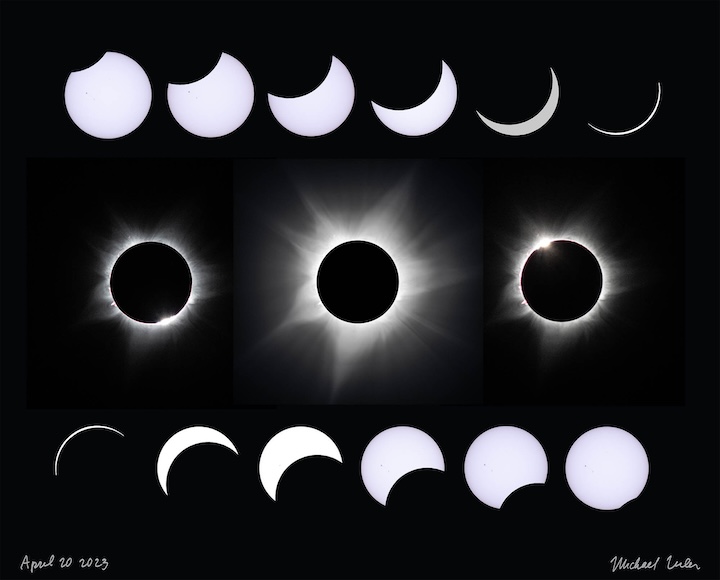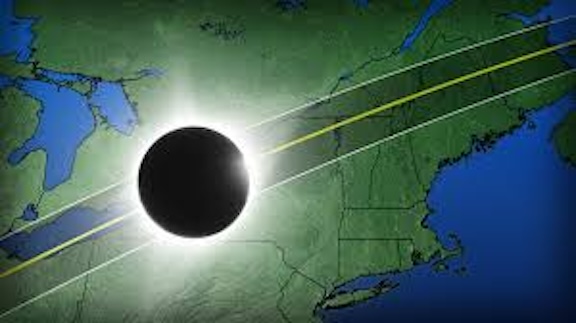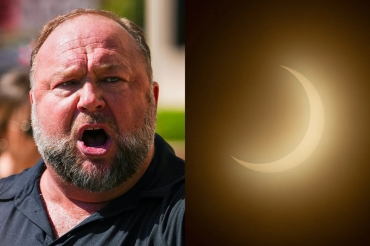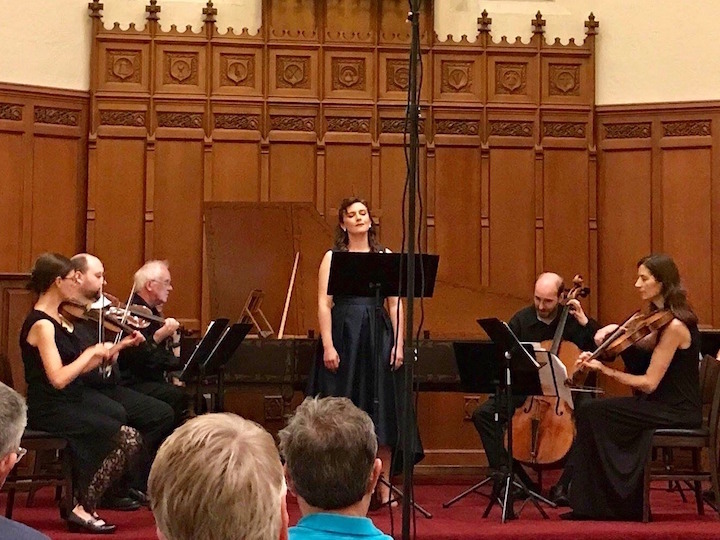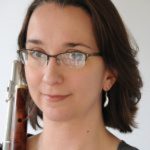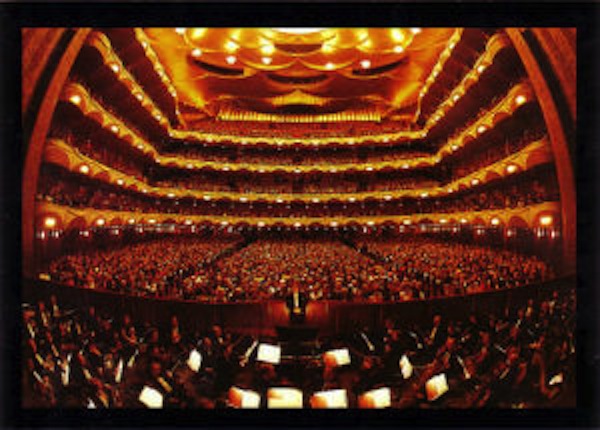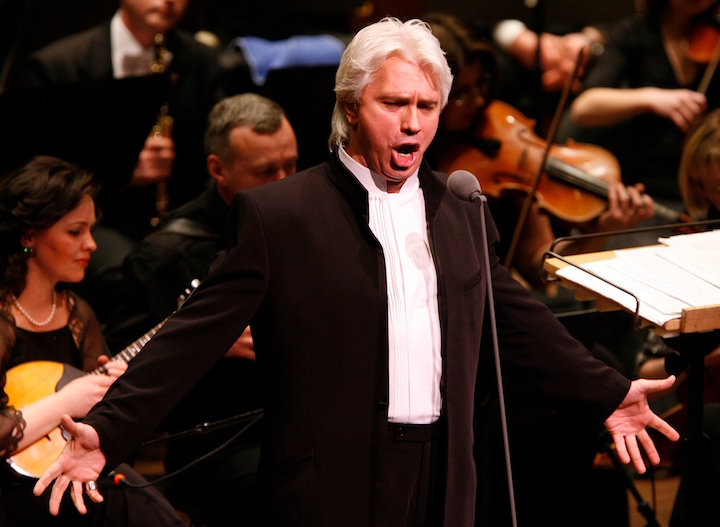The Well-Tempered Ear
Classical music plus tips for watching Monday’s solar eclipse
2 Comments
PLEASE HELP THE EAR. IF YOU LIKE A CERTAIN BLOG POST, SPREAD THE WORD. FORWARD A LINK TO IT OR, SHARE IT or TAG IT (not just “Like” it) ON FACEBOOK. Performers can use the extra exposure to draw potential audience members to an event. And you might even attract new readers and subscribers to the blog.
By Jacob Stockinger
This coming Monday, April 8, will see a rare solar eclipse crossing the United States and visible to varying degrees (below) in different locations. In Madison, it will start at 12:50 p.m. CST, peak at 2:05 and end at 3:20.
It got The Ear to thinking about appropriate classical music to listen to.
But some other information seems more important to convey first:
For last-minute tracking of the eclipse and traveling to see it, here are stories from NPR (National Public Radio) and PBS:
https://www.pbs.org/newshour/science/how-to-watch-the-2024-total-solar-eclipse
And from, MIT (the Massachusetts Institute of Technology), here are tips in the form of a Q&A about how to make the most out of viewing the eclipse:
https://news.mit.edu/2024/qa-brian-mernoff-tips-for-viewing-solar-eclipse-0404
NASA (the National Aeronautics and Space Administration) has some advice about watching the eclipse safely:
https://science.nasa.gov/eclipses/safety
If you want to watch the eclipse in real time from a place where a total eclipse — known as totality — will take place, the PBS NewsHour will live-stream it on YouTube. Here is a link, which also allows you to set up a notification starting at noon on Monday for the real-time broadcast:
A solar eclipse is an event that inspired awe and fear. It caused our pre-historic ancestors to beat the ground with sticks and exchange stories about the wrath of the gods.
These days it leads to even more conspiracy theories by more primitive-minded, far-right conspiracy theorists. Here is an an overview from Rolling Stone magazine of the nonsense that is being promulgated by Alex Jones (below, from Getty Images) and other popular science- and fact-deniers.
The Ear looked for some music to capture the feeling of the eclipse — the mystery and awe when it is happening, and the relief when it is over.
He’s pretty sure that on the radio, internet and elsewhere you will hear excerpts from “The Planets” by Gustav Holst; the “Moonlight” Sonata by Beethoven; maybe Haydn’s “Sunrise” string quartet, “Clair de lune” by Debussy; “Morning Mood” from “Peer Gynt Suite Suite” by Edvard Grieg; “Sunrise” from the “Grand Canyon Suite” by Ferde Grofé; the beautiful sunrise opening of the “Daphnis and Chloe Suite No. 2” by Ravel; and of course the dramatic opening sunrise to “Thus Spake Zarathustra” by Richard Strauss, which was made famous in the movie “2001: A Space Odyssey.”
But The Ear settled on the “Helios Overture” (in the YouTube video at the bottom) by the Danish composer Carl Nielsen. It is a haunting performance by the Royal Concertgebouw Orchestra and the American conductor Alan Gilbert.
Do you have a piece of classical music that you think would be appropriate for watching the eclipse?
The Ear wants to hear.
Tags: #BlogPost, #BlogPosting, #FacebookPost, #FacebookPosting, #YouTubevideo, 2001: A Space Odyssey, 2024, 88.7 FM, 89.9, advice, Alan Gilbert, Alex Jones, AM, America, American, Amsterdam, ancestor, Android, annular eclipse, Apple, appropriate, April, April 8, Arts, astronomy, audience, awe, beautiful, Beethoven, blog, Broadcast, Cello, Central Daylight Time, Chamber music, choral music, Clair de Lune, Classical, Classical music, composer, Concert, Concertgebouw, conservative, conspiracy theory, CST, Danish, Daphnis and Chloe, Debussy, denier, Denmark, different, dramatic, Dutch, Early music, eclipse, Facebook, fact-denier, facts, famous, fear, film, FM, God, gods, Google Alert, Google Search, Grand Canyon, Grieg, Grofe, happen, haunting, Haydn, Helios Overture, idiots, information, Infowars, Internet, Jacob Stockinger, link, live-stream, Ludwig van Beethoven, lunatics, Madison, magazine, Massachusetts Institute of Technology, Microsoft Bing, MIT, Monday, moon, moonlight, Morning Mood, movie, Music, Musica Antiqua, mystery, NASA, National Aeronautics and Space Administration, Netherlands, Nielsen, nonsense, notification, NPR, online, opera, Orchestra, OS, over, Overture, partial, PBS, PBS Newshour, Peer Gynt, peform, performance, Piano, popular, prehistoric, primitive, Radio, rare, Ravel, relief, right-wing, Rolling Stone, royal, Royal Concertgebouw Orchestra, Schubert, science, science-denier, search engine, share, singer, Singing, solar, solar eclipse, Sonata, song, soundtrack, space, stories, story, Strauss, stream, String quartet, Suite, sun, sunrise, symphony, tag, Television, The Ear, The Well-Tempered Ear, Thus Spake Zarathustra, tips, total, totality, TV, U.S., United States, University of Wisconsin-Madison School of Music, University of Wisconsin–Madison, Viola, Violin, vocal music, watch, Well-Tempered, Wisconsin, wisconsin public radio, Wolfgang Amadeus Mozart, WORT, WORT FM, WPR, wrath, YouTube
Classical music: This week brings Baroque music from Just Bach this Wednesday at noon and Sonata a Quattro next Sunday afternoon
3 Comments
PLEASE HELP THE EAR. IF YOU LIKE A CERTAIN BLOG POST, SPREAD THE WORD. FORWARD A LINK TO IT OR, SHARE IT or TAG IT (not just “Like” it) ON FACEBOOK. Performers can use the extra exposure to draw potential audience members to an event. And you might even attract new readers and subscribers to the blog.
By Jacob Stockinger
This week brings authentic Baroque music from two newer groups that employ period instruments and historically informed performance practices: Just Bach and Sonata a Quattro.
The concert for November by Just Bach (below, in a photo by John W. Barker, takes place this Wednesday, Nov. 20, from noon to 12:30 p.m. at Luther Memorial Church, 1021 University Ave, in Madison.
The performance is free and open to the public, with a good will offering collected.
Performers are: Sarah Brailey, soprano; Lindsey Meekhof, mezzo-soprano; Thore Dosdall, tenor; Paul Rowe, baritone; Linda Pereksta, flute; Kangwon Lee Kim and Nathan Giglierano, violins; Marika Fischer Hoyt, viola; James Waldo, cello; and Mark Brampton Smith, organ.
The program opens with the six-minute instrumental Sinfonia from Cantata 209. Just Bach favorite Linda Pereksta will be the featured flute soloist, backed up by the strings-and-organ band. (You can hear the Sinfonia in the YouTube video at the bottom.)
Cantata 151 ‘Süßer Trost, mein Jesus kommt‘ (Sweet comfort, my Jesus comes) closes the program. Each of the first four movements of this cantata features a different vocal soloist — the serene soprano aria also boasts a lovely flute obbligato — concluding with the chorale in which all take part.
Those who attend are invited to “bring your lunch, bring your ears and your voice, bring a friend, but most of all bring yourself to this stirring program of J.S. Bach.”
The next Just Bach program is Wednesday, Dec. 18, at noon.
For more information, go to:
https://www.facebook.com/events/451732972120968/
SONATA A QUATTRO
This week the Madison-based group Sonata à Quattro (below) will give two performances of its program “A Dark and Stormy Night”:
- Saturday, Nov. 23, at 7 p.m. at the St. Matthias Episcopal Church, 11 East Main St. in., Waukesha. Tickets for the general public, seniors and students are $15, $10 and $5 in advance; and $20, $15 and $10 at the door. Go to: stmatthiasepiscopalchurch.ticketleap.com/sonata-a-quarttro
- Sunday, Nov. 24 at 2:30 p.m. at the Madison Chinese Christian Church, 1510 Madison St., in Madison. Tickets $15 in advance or at the door. Online, go to: www.brownpapertickets.com/event/4429975
The program is:
- Motet: “In furore iustissimae irae” (In the fury of most righteous wrath), RV 626 by Antonio Vivaldi
- Quartet No. 1 in D Major by Johann Joachim Quantz
- Cello Sonata in C Minor, Book II No. 6 by Jean-Baptiste Barrière
- Concerto for 4 in D Minor, TWV 43:d2 by Georg Philipp Telemann
- Cantata 209: “Non sa che sia dolore” (He does not know what sorrow is) by Johann Sebastian Bach
Sonata à Quattro performers are: Christine Hauptly Annin and Nathan Giglierano, violins; Marika Fischer Hoyt, viola; Charlie Rasmussen, cello; Daniel Sullivan, harpsichord; and Kristin Knutson, soprano. Special guest artist is flutist Linda Pereksta (below, in a photo by Katrin Talbot).
Says founder and violist Marika Fischer Hoyt (below): “Join us for a program of dark and stormy pieces, on period-instruments. Sonata à Quattro’s third season opens with a program exploring the darker side of human experience, from Vivaldi’s motet, burning with godly rage, to Bach’s secular Cantata, deploring the departure of a beloved friend.
“Quantz’ bubbly Flute Quartet in D Major provides some needed moments of optimism, before we turn to the poignant, brooding Cello Sonata by Barrière. Even the viola gets a turn, in the Telemann, to unfold a haunting saga of tragic beauty.
“But the composers do not leave us in despair; each one leads the listener through the dark night of the soul, to the morning after.”
The Bach Cantata opens with an instrumental Sinfonia, heard in the YouTube video at the bottom, that features flutist Linda Pereksta, who also plays in the works by Quantz and Telemann.
For more information, go to:
Tags: #AntonioVivaldi, #BachCantata, #BaritoneSinger, #BaroqueCello, #BaroqueMusic, #BlogPost, #BlogPosting, #BrownPaperTickets, #CelloSonata, #ChamberMusic, #ChoralMusic, #DarkerSide, #EpiscopalChurch, #FacebookPost, #FacebookPosting, #GeorgPhilippTelemann, #GuestArtist, #HarpsichordContinuo, #HistoricallyInformedPerformancePractices, #HumanExperience, #HumanSpiirt, #James Waldo, #JamesWaldo, #JesusChrist, #JohannJoachimQuantz, #JohannSebastianBach, #JohnW.Barker, #JustBach, #KangwonKim, #LindaPereksta, #LindseyMeekhof, #LutherMemorialChurch, #MadisonChineseChristianChurch, #MarikaFischerHoyt, #MarkBramptonSmith, #Mezzo-sopranoSinger, #NathanGiglierano, #PaulRowe, #PeriodInstruments, #SarahBrailey, #SonataaQuattro, #SopranoSinger, #St.MatthiasEpiscopalChurch, #StringMusic, #TheEar, #ThoreDosdall, #VocalMusic, #WaukeshaWisconsin, #YouTubevideo, Antonio Vivaldi, aria, Arts, audience, authentic, Bach, Bach cantata, band, baritone, Baroque, Baroque music, blog, brooding, Brown Paper Tickets, Cantata, cellist, Cello, Cello Sonata, Chamber music, Chamber Music America, China, Chinese, choral music, Chorale, Christ, Christian, Christianity, church, Classical music, comfort, composer, Concert, concerto, dark, darker, December, despair, dorector, Early music, earlymusic, ears, eat, Episcopal, experience, Facebook, flute, flutist, forward, founder, free, friend, Georg Philipp Telemann, good will, group, guest artist, harpsichord, historically informed performance practices, Jacob Stockinger, Jean-Baptiiste Barrière, Jean-Baptiste Carrière, Jesus, Jesus Christ, Johann Joachim Quantz, Johann Sebastian Bach, John W. Barker, Just Bach, Kangwon Kim, like, Linda Pereksta, Lindsey Meekhof, link, Lord, lovely, lunch, Luther Memorial Church, Lutheran, Madison, Madison Chinese Christian Church, Marika Fischer Hoyt, Mark Brampton Smith, Mezzo-soprano, morning, motet, Music, Nathan Giglierano, new, night, November, obbligato, offering, online, optimism, Orchestra, organ, organist, Paul Rowe, performer, period instruments, plays, poignant, post, posting, public, Quantz, Quartet, righteous, Sarah Brailey, Season, seniors, serene, share, side, sinfonia, singer, singers, Sonata, Sonata à Quattro, soprano, sorrow, soul, St. Matthias Episcopal Church, stormy, strings, Student, sweet, symphony, tag, Telemann, The Ear, Thore Dosdall, tickets, United States, Viola, Violin, violinist, Vivaldi, vocal music, voice, Waukesha, week, Wisconsin, works, wrath, YouTube
Classical music: Live radio broadcasts from the Metropolitan Opera start their 87th season with the Verdi Requiem at NOON this Saturday on Wisconsin Public Radio.
Leave a Comment
By Jacob Stockinger
What is the longest-running classical music broadcast on American radio?
If you said the live Saturday matinee broadcasts from the Metropolitan Opera (below) in New York City, you got it right.
So, does that qualify the Met, and opera in general, as pop culture?
Does it do anything to reassure those who worry about the future of opera and classical music?
Anyway, the 87th broadcast season starts again on Wisconsin Public Radio this Saturday morning and runs through May 5.
Of course, not there are also the popular and more cinematic broadcasts of “Live From the Met in HD.” But many listeners still prefer the radio — which is FREE — to help them focus on the music, not the visual and theatrical aspects, and to use their imagination more.
On Saturday at the usual time of NOON — not 11:05 a.m. as was mistakenly first published here — the Met features a performance of the dramatic Requiem by opera great Giuseppe Verdi (below). (You can hear the operatic Dies Irae, or Day of Wrath, section in the YouTube video at the bottom.)
The Requiem will be conducted by James Levine (below), the now retired longtime artistic director of the Met.
The 90-minute performance will dedicated to the famed Russian baritone Dmitri Hvorostovsky (below bottom), who died two weeks ago from a brain tumor at age 55. For more information about the late singer, go to:
For as complete schedule of the works to be performed, which include well-known standards by Mozart, Rossini, Donizetti, Bellini, Verdi, Puccini, Wagner and Richard Strauss as well as a contemporary work by Thomas Adès, go to the WPR website:
https://www.wpr.org/metropolitan-opera-begins-its-87th-broadcast-season
Tags: Adès, Arts, Bellini, Brain, brain tumor, Broadcast, cancer, choral music, cinema, Classical music, composer, day, dedicated, Dmitri Hvorostovsky, Donizetti, drama, dramatic, future, Gaetano Donizetti, Giuseppe Verdi, imagination, Italy, Jacob Stockinger, James Levine, listener, Live From The Met in HD, matinee, Metropolitan Opera, Mozart, Music, New York City, opera, Orchestra, performance, pop, pop culture, Puccini, Radio, Requiem, Rossini, Saturday, schedule, Season, standard, Strauss, theater, theatre, theatrical, tumor, United States, visual, Wagner, Website, Wisconsin, wisconsin public radio, work, WPR, wrath, YouTube
- May 2024
- April 2024
- March 2024
- February 2024
- January 2024
- December 2023
- November 2023
- October 2023
- September 2023
- August 2023
- July 2023
- June 2023
- May 2023
- April 2023
- March 2023
- February 2023
- January 2023
- December 2022
- October 2022
- September 2022
- June 2022
- May 2022
- April 2022
- March 2022
- July 2021
- June 2021
- May 2021
- April 2021
- March 2021
- February 2021
- January 2021
- December 2020
- November 2020
- October 2020
- September 2020
- August 2020
- July 2020
- June 2020
- May 2020
- April 2020
- March 2020
- February 2020
- January 2020
- December 2019
- November 2019
- October 2019
- September 2019
- August 2019
- July 2019
- June 2019
- May 2019
- April 2019
- March 2019
- February 2019
- January 2019
- December 2018
- November 2018
- October 2018
- September 2018
- August 2018
- July 2018
- June 2018
- May 2018
- April 2018
- March 2018
- February 2018
- January 2018
- December 2017
- November 2017
- October 2017
- September 2017
- August 2017
- July 2017
- June 2017
- May 2017
- April 2017
- March 2017
- February 2017
- January 2017
- December 2016
- November 2016
- October 2016
- September 2016
- August 2016
- July 2016
- June 2016
- May 2016
- April 2016
- March 2016
- February 2016
- January 2016
- December 2015
- November 2015
- October 2015
- September 2015
- August 2015
- July 2015
- June 2015
- May 2015
- April 2015
- March 2015
- February 2015
- January 2015
- December 2014
- November 2014
- October 2014
- September 2014
- August 2014
- July 2014
- June 2014
- May 2014
- April 2014
- March 2014
- February 2014
- January 2014
- December 2013
- November 2013
- October 2013
- September 2013
- August 2013
- July 2013
- June 2013
- May 2013
- April 2013
- March 2013
- February 2013
- January 2013
- December 2012
- November 2012
- October 2012
- September 2012
- August 2012
- July 2012
- June 2012
- May 2012
- April 2012
- March 2012
- February 2012
- January 2012
- December 2011
- November 2011
- October 2011
- September 2011
- August 2011
- July 2011
- June 2011
- May 2011
- April 2011
- March 2011
- February 2011
- January 2011
- December 2010
- November 2010
- October 2010
- September 2010
- August 2010
- July 2010
- June 2010
- May 2010
- April 2010
- March 2010
- February 2010
- January 2010
- December 2009
- November 2009
- October 2009
- September 2009
- August 2009
Archives
- 2,493,291 hits
Blog Stats
Recent Comments
| welltemperedear on What do you think of the… | |
| Scott on What do you think of the… | |
| welltemperedear on Yunchan Lim’s Chopin etudes ar… | |
| bratschespeilerin on What do you think of the… | |
| MARVIN P WICKENS on Yunchan Lim’s Chopin etudes ar… |
Tags
#BlogPost #BlogPosting #ChamberMusic #FacebookPost #FacebookPosting #MeadWitterSchoolofMusic #TheEar #UniversityofWisconsin-Madison #YouTubevideo Arts audience Bach Baroque Beethoven blog Cello Chamber music choral music Classical music Compact Disc composer Concert concerto conductor Early music Facebook forward Franz Schubert George Frideric Handel Jacob Stockinger Johannes Brahms Johann Sebastian Bach John DeMain like link Ludwig van Beethoven Madison Madison Opera Madison Symphony Orchestra Mead Witter School of Music Mozart Music New Music New York City NPR opera Orchestra Overture Center performer Pianist Piano post posting program share singer Sonata song soprano String quartet Student symphony tag The Ear United States University of Wisconsin-Madison School of Music University of Wisconsin–Madison Viola Violin vocal music Wisconsin Wisconsin Chamber Orchestra wisconsin public radio Wolfgang Amadeus Mozart YouTube